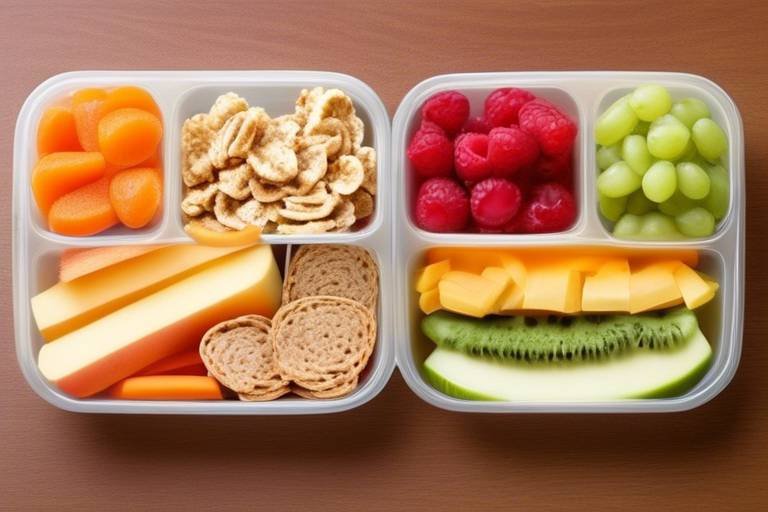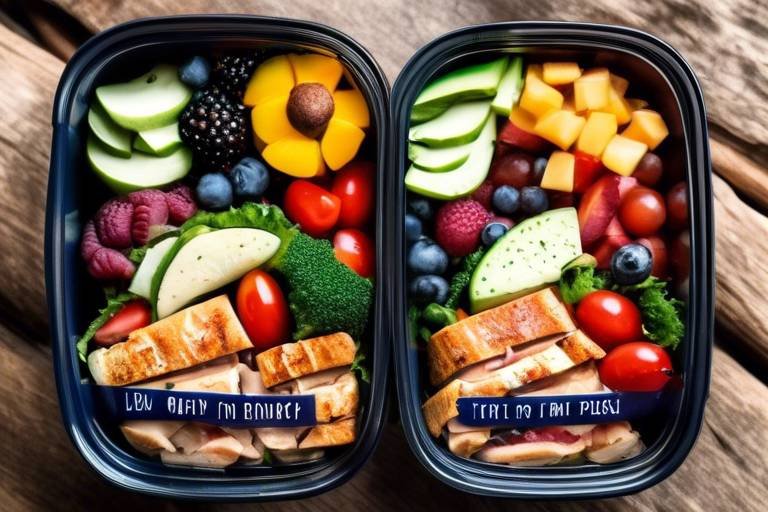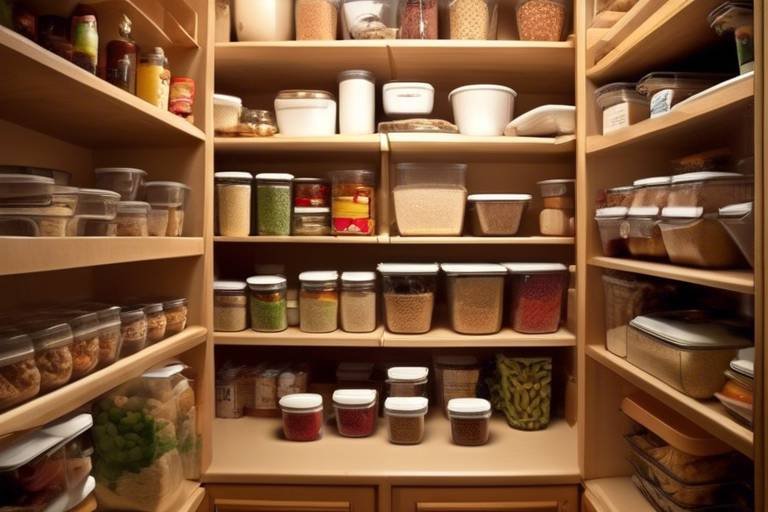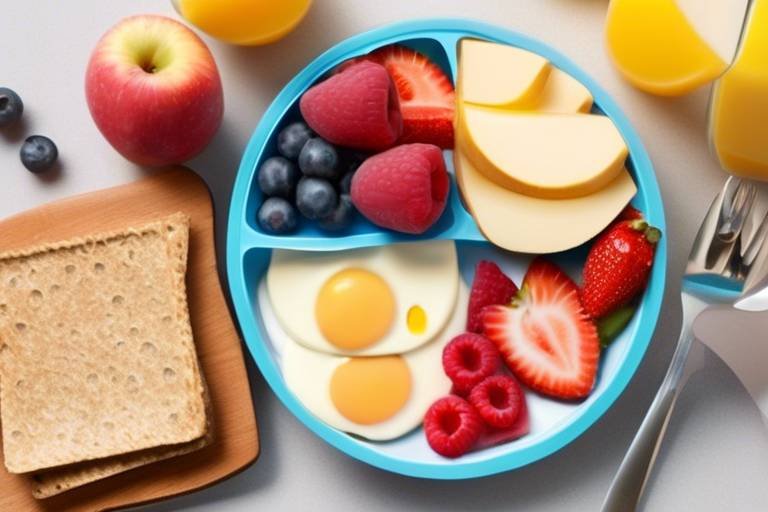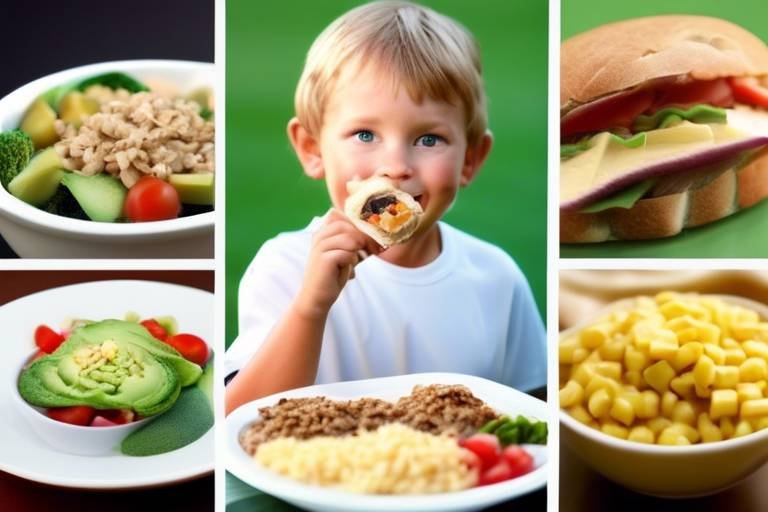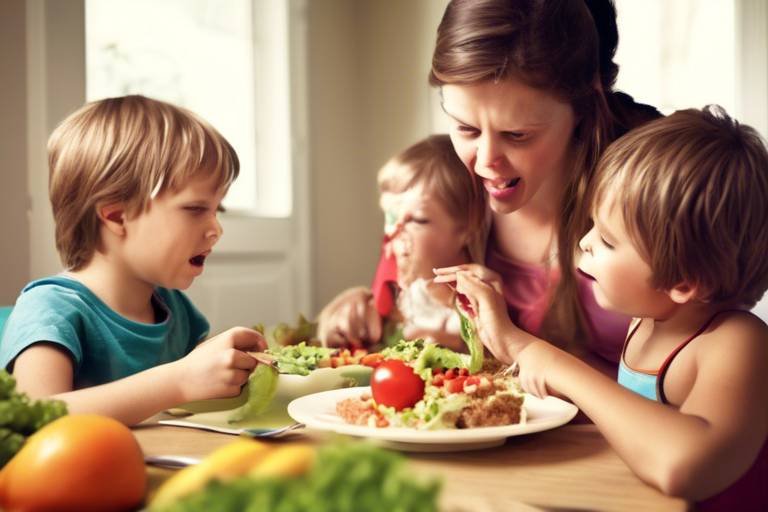Healthy Mid-Day Snacks for Kids at School
In today's fast-paced world, ensuring that our children have access to nutritious snacks during school hours is more important than ever. With busy schedules and the need for constant energy, kids require snacks that not only taste great but also provide the necessary fuel for their growing bodies and active minds. Healthy mid-day snacks can play a vital role in enhancing focus, improving concentration, and supporting overall well-being. So, what are some delicious options that parents can pack for their little ones?
Understanding the significance of healthy snacks can empower parents to make better nutritional choices for their children. Snacks are not just a way to stave off hunger; they are an opportunity to incorporate essential nutrients into a child's diet. A balanced snack can help maintain energy levels, support cognitive function, and even improve mood. With the right snacks, children can experience improved academic performance and increased engagement in their learning activities. Think of healthy snacks as the fuel that keeps the engine running smoothly throughout the school day!
When it comes to packing snacks for school, variety is key. Children often get bored with the same old options, so offering a range of healthy snacks can keep them excited about their food. Here are some nutritious snack ideas that are not only easy to prepare but also packed with flavor:
Fresh fruits and vegetables are the cornerstone of a healthy diet. They are loaded with vitamins, minerals, and fiber, all of which are essential for a child's growth and development. By incorporating these colorful foods into school snacks, parents can help their children develop a taste for healthy eating that can last a lifetime.
Why not make snacking fun? Combining different fruits can create vibrant and appealing snacks that kids will love. For instance, try pairing strawberries with bananas or mixing blueberries with yogurt for a delightful treat. You could even create a fruit kabob using skewers, making it a hands-on snack that’s easy to eat on the go!
Veggies can sometimes get a bad rap, but with the right presentation, they can be a hit! Consider offering a selection of colorful vegetable dippers, such as carrots, bell peppers, and cucumbers, paired with a healthy dip like hummus or yogurt-based dressing. This not only makes veggies more appealing but also ensures that children are getting the essential nutrients they need.
Don't forget about whole grains and proteins! Snacks that include these components can provide sustained energy, helping kids stay focused throughout the school day. Think of whole grain crackers, nut butter, or even a small sandwich made with whole grain bread. These options are not only filling but also nutritious, ensuring that children are ready to tackle their next class with vigor.
Preparing healthy snacks doesn’t have to be a daunting task. With a few simple tips, parents can streamline the process and ensure that their kids have nutritious options readily available. Consider dedicating a little time on the weekends to prepare snacks in advance. This can save time during the busy weekdays and make healthy eating more convenient.
Batch cooking is a fantastic way to simplify snack preparation. Over the weekend, parents can whip up a batch of healthy muffins, energy bites, or granola bars. These can be stored in the fridge or freezer, allowing for quick grab-and-go snacks during the week. It’s a win-win situation: kids get nutritious snacks, and parents save time!
Another great way to encourage healthy eating habits is by involving kids in the snack preparation process. When children help make their snacks, they are more likely to enjoy them and choose nutritious options. This can be as simple as letting them pick out their favorite fruits or helping to mix ingredients for a homemade trail mix. Not only does this foster independence, but it also teaches them valuable cooking skills!
- What are some quick healthy snack options? Quick options include yogurt with fruit, whole grain toast with nut butter, or pre-cut veggie sticks with hummus.
- How can I make snacks more appealing to my kids? Use fun shapes, colorful combinations, and involve them in the preparation process to make snacks more exciting.
- Is it okay to include sweets in school snacks? Moderation is key! Consider healthier sweet options like dark chocolate or yogurt-covered fruit.

Importance of Healthy Snacks
Understanding why healthy snacks are crucial for kids during school can help parents make better choices for their children's nutrition. Think about it: children are like little engines, and just like any engine, they need the right fuel to run smoothly. When kids munch on nutritious snacks, they not only get the energy they need to power through their day but also the essential nutrients that support their growth and development. A well-balanced diet plays a significant role in enhancing concentration and overall well-being, making it easier for them to absorb information in class.
Moreover, incorporating healthy snacks into their daily routine can help establish lifelong habits. When kids learn to enjoy fruits, vegetables, and whole grains at a young age, they are more likely to continue making healthy choices as they grow older. It's not just about keeping them full; it's about setting them up for a lifetime of healthy eating. Parents can play a pivotal role by introducing a variety of snacks that are both delicious and nutritious.
Here are a few reasons why healthy snacks are essential for school-aged children:
- Energy Boost: Healthy snacks provide the necessary energy to keep kids active and engaged throughout the school day.
- Cognitive Function: Nutrient-rich foods can enhance brain function, leading to improved focus and better academic performance.
- Weight Management: Healthy snacking can help prevent overeating at meal times and promote a healthy weight.
- Growth and Development: Essential vitamins and minerals from snacks support physical growth and cognitive development.
In conclusion, healthy snacks are not just a way to curb hunger; they are a vital component of a child's diet that supports their physical, mental, and emotional well-being. By choosing the right snacks, parents can help their kids thrive in school and beyond.

Nutritious Snack Ideas
When it comes to fueling our little ones during the school day, having a variety of nutritious snack options is essential. Kids need snacks that not only taste great but also provide the energy and nutrients necessary for their growing bodies and active minds. Think of snacks as mini-meals that can help bridge the gap between breakfast and lunch, or lunch and dinner. By choosing the right snacks, you can help your child maintain their energy levels and focus throughout the day.
One fantastic way to ensure your kids are getting the nutrition they need is by incorporating a mix of fruits, vegetables, whole grains, and protein-rich foods. These options are not just healthy; they can also be fun and exciting! For instance, consider packing a small container of Greek yogurt with a sprinkle of granola and some fresh berries. This combination not only tastes delicious but also packs a protein punch that can keep kids satisfied until their next meal.
Another great idea is to prepare homemade trail mix. You can mix together a variety of nuts, seeds, and dried fruits to create a snack that's both tasty and nutritious. Not only is it easy to make, but it also allows for customization based on your child's preferences. Plus, trail mix is perfect for on-the-go snacking! Just be mindful of portion sizes, as it's easy to overindulge when it comes to nuts and dried fruits.
In addition to these options, don't overlook the power of whole grain crackers paired with cheese or hummus. This combo provides a good balance of carbohydrates and protein, making it a satisfying snack that will help keep hunger at bay. You could also consider making energy bites using oats, nut butter, and honey. These no-bake snacks are quick to prepare and can be stored in the fridge for a grab-and-go option.
Lastly, remember that presentation matters! Kids are more likely to eat healthy snacks if they look appealing. Use colorful containers or fun shapes to make the snacks visually exciting. You might even involve your kids in the preparation process; let them choose their favorite fruits or help you assemble their snacks. This involvement can increase their interest in eating healthy and make snacking a fun activity!
To inspire you further, here are some creative snack ideas that blend nutrition with fun:
- Fruit Kabobs: Skewer pieces of various fruits for a colorful and interactive snack.
- Veggie and Dip Cups: Pack a small cup of hummus or yogurt dip with sliced veggies for a crunchy treat.
- Peanut Butter Banana Roll-Ups: Spread peanut butter on a whole grain tortilla, add a banana, roll it up, and slice it into pinwheels.
- Cheese and Apple Slices: Pair cheese cubes with apple slices for a sweet and savory combination.
By incorporating these nutritious snack ideas into your child's school routine, you're not only helping them stay energized but also instilling healthy eating habits that can last a lifetime. Remember, the key is to keep it varied, colorful, and fun!
Q: What are some good snacks for kids with allergies?
A: Always check for allergens, but some safe options can include fruits, veggies, rice cakes, or homemade snacks using allergy-friendly ingredients.
Q: How can I make snacks more appealing to picky eaters?
A: Try involving them in the preparation process or presenting snacks in fun shapes and colors. Sometimes, a little creativity can go a long way!
Q: How can I ensure my child is getting enough nutrients from their snacks?
A: Aim for a balance of protein, whole grains, fruits, and vegetables in their snacks. This variety will help cover different nutritional needs.

Fruits and Vegetables
When it comes to keeping our little ones energized and focused during school hours, are the unsung heroes of healthy snacking. These colorful, nutrient-packed foods not only provide essential vitamins and minerals but also play a pivotal role in promoting overall health. Imagine a classroom filled with bright, cheerful kids, their minds sharp and ready to learn—this is the magic that fresh produce can bring to their day! By incorporating a variety of fruits and vegetables into their lunchboxes, parents can ensure that their children are not just filling their tummies but fueling their brains.
Fruits are nature's candy—sweet, juicy, and oh-so-delicious! They come in all shapes and sizes, making them easy to pack and fun to eat. From the simplicity of an apple to the exotic taste of a mango, the options are endless. Pairing fruits with a little protein, like yogurt or nut butter, can enhance the taste and provide sustained energy. For example, try sending along some apple slices with a small container of peanut butter for dipping, or a handful of grapes alongside a cheese stick. The combination not only satisfies hunger but also keeps kids engaged and ready to tackle their studies.
On the other hand, vegetables often get a bad rap—kids might turn their noses up at a carrot stick or a slice of cucumber. However, with a little creativity, veggies can become a favorite snack! Think of veggie dippers served with tasty dips like hummus or yogurt-based dressings. This not only makes eating vegetables more enjoyable but also introduces children to a variety of flavors and textures. A rainbow of veggies can be packed into their lunch:
- Carrot sticks
- Bell pepper strips
- Cucumber slices
- Cherry tomatoes
Incorporating fruits and vegetables into daily snacks lays the groundwork for healthy eating habits that can last a lifetime. It’s about making these foods accessible and appealing. Perhaps you could create a fun challenge where your kids try a new fruit or vegetable each week, turning snack time into a delightful exploration of flavors. Not only does this encourage them to eat better, but it also opens the door to conversations about nutrition and the importance of a balanced diet. So, the next time you're packing lunch, remember: a little creativity can transform simple fruits and veggies into a delicious and energizing snack!
Q: How can I encourage my child to eat more fruits and vegetables?
A: Get creative! Involve them in snack preparation, make fun presentations, and introduce them to new flavors through dips and combinations.
Q: Are there any fruits or vegetables that are better for school snacks?
A: While all fruits and vegetables are beneficial, choose those that are easy to pack and eat, such as apples, bananas, carrots, and cherry tomatoes.
Q: Can I prepare fruits and vegetables in advance?
A: Absolutely! Pre-cut fruits and veggies can be stored in containers in the fridge, making it easy to grab and pack for school lunches.

Creative Fruit Combinations
When it comes to making healthy snacks appealing for kids, creativity is key! Incorporating a variety of fruits into fun combinations can transform an ordinary snack into an exciting treat. Think of it like painting a masterpiece; the more colors you add, the more vibrant and enticing it becomes. For example, mixing vibrant strawberries with juicy kiwis not only creates a beautiful visual but also packs a punch of flavor and nutrition. You can even add a sprinkle of coconut flakes or a drizzle of honey to elevate the taste and make it even more delightful.
Another fun idea is to create a fruit salad that tells a story! You can use seasonal fruits to keep it fresh and exciting. Imagine a tropical theme with mangoes, pineapples, and bananas all chopped up and mixed together. Not only does this combination taste amazing, but it also introduces kids to new flavors they might not usually choose. You can even involve them in the preparation process, allowing them to choose their favorite fruits and help mix them together.
For a playful twist, consider making fruit skewers. Kids love to eat with their hands, and threading pieces of fruit onto a skewer can make for a fun and interactive snack. You can alternate between different fruits like grapes, melon, and blueberries. These colorful skewers not only look appealing but also encourage kids to try a variety of fruits without feeling overwhelmed. Plus, they can even dip them in yogurt for an added treat!
To make it even more engaging, you might consider creating themed fruit plates. For instance, a rainbow fruit platter can be a fun way to introduce kids to the concept of eating the rainbow. You can arrange fruits in the order of the colors of the rainbow, from red (strawberries) to violet (blackberries). This visual appeal can stimulate their interest and encourage them to taste each fruit. The goal here is to make healthy eating an adventure rather than a chore!
In conclusion, the key to making healthy fruit snacks exciting lies in creativity and presentation. By combining flavors, colors, and textures, you can create an array of options that not only satisfy hunger but also contribute to a balanced diet. Remember, the more fun and appealing the snacks are, the more likely kids will be to eat them. So, unleash your inner artist in the kitchen and watch as your kids embrace these delicious, nutritious combinations!

Veggie Dippers
When it comes to getting kids to eat their vegetables, presentation is key! are not just a fun way to serve vegetables; they can also be a colorful and nutritious addition to your child's school snack. Imagine a lunchbox bursting with vibrant colors—crunchy carrots, crisp cucumbers, and sweet bell peppers—all waiting to be dipped into a variety of delicious and healthy dips. By transforming veggies into dippers, you’re not only making them more appealing but also encouraging your kids to enjoy their greens without the usual fuss.
One of the best aspects of veggie dippers is their versatility. You can mix and match different vegetables based on what your child enjoys or what’s in season. For example, consider pairing carrot sticks with a creamy hummus, or celery with a tangy ranch dip. The possibilities are endless! Moreover, involving kids in the selection and preparation of these snacks can make them more excited about eating vegetables. Let them choose their favorite dips and vegetables, and watch as they take ownership of their healthy choices.
To make it even more interesting, you can create a dipping platter. This could include a variety of vegetables and dips, making it feel like a mini feast. Here’s a quick idea for a colorful veggie dip platter:
| Vegetable | Dip |
|---|---|
| Carrot Sticks | Hummus |
| Cucumber Slices | Tzatziki |
| Bell Pepper Strips | Guacamole |
| Cherry Tomatoes | Ranch Dressing |
By preparing these veggie dippers ahead of time, you can save precious minutes in the morning rush. Simply chop the vegetables and pack them in small containers, pairing them with the dips of your choice. Not only will your child enjoy a tasty and healthy snack, but they’ll also be fueling their body with essential vitamins and minerals that support their growth and concentration throughout the school day. So why not make veggie dippers a staple in your child's lunchbox? It’s a simple yet effective way to promote healthy eating habits that can last a lifetime.
1. How can I make my kids more interested in eating vegetables?
Incorporating fun presentations, like veggie dippers, and allowing them to choose their favorite vegetables and dips can spark their interest. Involving them in the preparation process also encourages them to try new things.
2. What are some good dips to pair with veggie dippers?
Healthy dips like hummus, guacamole, tzatziki, and yogurt-based dressings are excellent choices. They not only add flavor but also provide additional nutrients.
3. Can I prepare veggie dippers ahead of time?
Absolutely! Preparing veggie dippers in advance can save time during busy mornings. Just store them in airtight containers in the fridge to keep them fresh.
4. Are there any vegetables that are better for kids?
Most vegetables are beneficial, but some favorites among kids include carrots, cucumbers, bell peppers, and cherry tomatoes due to their crunchiness and sweetness.

Whole Grains and Proteins
When it comes to fueling our kids' bodies and minds, whole grains and proteins are the dynamic duo that can make all the difference. Think of whole grains as the sturdy foundation of a house; they provide the essential energy that keeps kids active and engaged throughout their busy school day. Whole grains, such as brown rice, quinoa, and whole wheat bread, are packed with fiber and nutrients that help maintain steady energy levels, preventing those dreaded mid-afternoon slumps. Meanwhile, proteins are like the builders, working tirelessly to support growth and development. Foods rich in protein, such as nuts, yogurt, and lean meats, play a crucial role in repairing tissues and keeping our children feeling full and satisfied.
Combining these two food groups can create a powerhouse of a snack. For example, consider a delightful whole grain wrap filled with turkey and spinach, or a bowl of oatmeal topped with nuts and fruits. Not only are these snacks delicious, but they also provide a balance of carbohydrates and proteins that can help kids stay focused in class. Imagine your child sitting in math class, fully energized and ready to tackle those tricky problems, thanks to a wholesome snack!
In addition to being nutritious, whole grains and proteins can be incredibly versatile. Here are some fun and creative snack ideas that incorporate these vital components:
- Whole Grain Crackers with Hummus: A crunchy and creamy combination that packs a protein punch.
- Greek Yogurt Parfait: Layer yogurt with whole grain granola and fresh berries for a sweet treat that’s also filling.
- Peanut Butter on Whole Wheat Toast: A classic choice that’s both satisfying and nutritious.
By incorporating whole grains and proteins into their snacks, parents can help their children maintain consistent energy levels, which is essential for concentration and learning. It's important to remember that the right snacks can set the tone for a productive day at school. So next time you're packing a lunch or a snack, think about how you can include these wholesome ingredients to give your child the best chance at success!
Q: Why are whole grains important for kids?
A: Whole grains provide essential nutrients and fiber that support healthy digestion and sustained energy levels, which are crucial for active children.
Q: How can I make protein-rich snacks appealing to my kids?
A: Try incorporating fun dips, colorful presentations, and mixing proteins with their favorite flavors, like yogurt with honey or nut butter with fruits.
Q: Can I prepare whole grain and protein snacks ahead of time?
A: Absolutely! Many snacks, like overnight oats or whole grain muffins, can be prepped in advance, making it easier to provide healthy options during the week.

Snack Preparation Tips
Preparing healthy snacks for your kids doesn't have to be a daunting task. In fact, with a few simple strategies, you can make the process efficient and enjoyable for both you and your children. One of the best ways to streamline your snack prep is to set aside some time on the weekend for batch cooking. This means whipping up large quantities of snacks that can be portioned out and stored for the week ahead. Think of it like meal prepping for snacks! For instance, you could bake a batch of whole grain muffins or make energy balls using oats, nut butter, and a hint of honey. By doing this, you’ll have quick and nutritious options ready to go, which can save you time during those hectic school mornings.
Another fantastic tip is to involve your kids in the snack preparation process. Not only does this make them feel more invested in what they eat, but it also teaches them valuable skills in the kitchen. You can turn snack prep into a fun activity by letting them choose their favorite fruits or help assemble veggie dippers with hummus. When kids are part of the decision-making and preparation, they're often more excited about eating the snacks they helped create. Plus, this encourages them to try new foods and develop healthier eating habits.
When packing snacks for school, consider using small containers or reusable snack bags. This not only keeps the snacks fresh but also allows for a bit of variety. For example, you might pack a small container of yogurt with a side of granola, or some apple slices with almond butter. Mixing and matching can make snack time feel like a mini-adventure, keeping your kids engaged and excited about their food choices. Remember, presentation matters! A colorful array of snacks can make even the healthiest options look appealing. So, don’t hesitate to get creative with how you arrange those fruits and veggies!
Lastly, always keep an eye on the nutritional balance of the snacks you prepare. Aim for a combination of whole grains, proteins, and healthy fats to ensure that your kids are getting a well-rounded snack. For instance, pairing whole grain crackers with cheese or nut butter provides a great mix of nutrients that will keep them energized throughout the day. By following these tips, you can make snack preparation a breeze while ensuring your kids are fueled with healthy options that support their growth and learning.
Q: What are some quick snack ideas for busy mornings?
A: Some quick snack ideas include yogurt parfaits made with granola and fruit, whole grain wraps with turkey and cheese, or pre-packaged nut and dried fruit mixes. These can be prepared in advance and are easy to grab on the way out the door!
Q: How can I encourage my kids to eat more fruits and vegetables?
A: Try making fruits and vegetables fun! Use cookie cutters to create shapes, or involve them in the preparation process. Offering a variety of dips, like yogurt or hummus, can also make veggies more appealing.
Q: Can I freeze snacks for later use?
A: Absolutely! Many snacks, such as muffins, energy balls, and even some fruits, can be frozen. Just ensure they're stored in airtight containers or freezer bags to maintain their freshness.

Batch Cooking Ideas
Batch cooking is a game-changer for busy parents looking to provide their kids with healthy snacks throughout the school week. Imagine this: you dedicate a few hours on the weekend to prepare a variety of snacks, and then you have nutritious options ready to go for the entire week! This not only saves time but also ensures that your children have access to wholesome foods that keep them energized and focused during their studies.
One of the best ways to start batch cooking is by selecting a few versatile snack recipes that can be easily scaled up. For instance, consider making a big batch of homemade granola bars. These bars can be packed with oats, nuts, seeds, and dried fruits, providing a great source of energy. Not to mention, they can be customized to suit your child's taste preferences, making them more likely to enjoy what they eat. After baking, simply cut them into squares and store them in an airtight container. They can last for a week or even longer!
Another fantastic idea is to prepare fruit and veggie muffins. You can sneak in some vegetables like spinach or carrots along with fruits such as bananas or apples. These muffins are not only delicious but also packed with nutrients. Bake a large batch and freeze them; just pop them in the fridge the night before school, and they’ll be ready to go by morning!
Don't forget about energy balls! These little bites are super easy to make and can be a hit with kids. Combine oats, nut butter, honey, and add-ins like chocolate chips or coconut flakes. Roll them into balls and refrigerate. They make for a quick, satisfying snack that can be eaten on the go!
For those who prefer a savory option, consider batch-cooking hummus or other healthy dips. Pair these with sliced veggies or whole-grain crackers for a crunchy, satisfying snack. You can make a variety of dips, such as roasted red pepper, garlic, or classic chickpea hummus, to keep things interesting throughout the week. Store them in small containers for easy packing.
Here’s a quick overview of some batch cooking ideas:
| Snack Idea | Ingredients | Storage Method |
|---|---|---|
| Granola Bars | Oats, nuts, seeds, dried fruits | Airtight container |
| Fruit & Veggie Muffins | Flour, fruits, veggies, eggs | Freezer |
| Energy Balls | Oats, nut butter, honey, add-ins | Refrigerator |
| Hummus | Chickpeas, tahini, lemon, garlic | Small containers |
By incorporating these batch cooking ideas into your weekend routine, you can take the stress out of daily snack preparation. It’s not just about saving time; it’s about fostering a healthier lifestyle for your kids. Plus, when children see their parents taking the time to prepare nutritious snacks, it sets a positive example and encourages them to make healthier choices on their own.
Q: How long do batch-cooked snacks stay fresh?
A: Most batch-cooked snacks can last up to a week in the refrigerator and several weeks in the freezer. Always check for any signs of spoilage before consumption.
Q: Can I involve my kids in the batch cooking process?
A: Absolutely! Involving kids in the kitchen can be a fun way to teach them about healthy eating and cooking. They can help with mixing ingredients, pouring, and even decorating their snacks.
Q: What are some quick snacks I can prepare if I forget to batch cook?
A: If you’re in a pinch, consider quick options like yogurt with fruit, cheese sticks, or whole-grain crackers with nut butter. These can be put together in minutes!

Involving Kids in Snack Prep
Getting kids involved in snack preparation is not only a fantastic way to teach them about nutrition, but it can also be a fun bonding experience. Imagine this: your child, with a chef's hat on, enthusiastically mixing ingredients or arranging colorful fruits on a plate. It’s more than just making snacks; it’s about instilling a sense of responsibility and creativity in them. When children participate in preparing their own snacks, they are more likely to appreciate the food they eat and make healthier choices.
One effective approach is to create a "snack station" in your kitchen. This can be a designated area stocked with various healthy ingredients. You might include whole grain crackers, a selection of fruits, vegetables, and dips like hummus or yogurt. Allowing your kids to choose their ingredients empowers them to make decisions about their snacks. This not only fosters independence but also sparks their interest in trying new foods. When kids have a hand in the process, they often feel more invested in the outcome, making them more likely to enjoy the snacks they’ve helped create.
Moreover, you can turn snack prep into a fun learning opportunity. For instance, while preparing a fruit salad, you could discuss the different vitamins and minerals found in each fruit. This type of interaction not only educates them but also makes them more aware of what they are eating. You can even create a simple chart together that lists the nutritional benefits of each ingredient used, making it a fun project that combines cooking with learning.
Here are some simple ideas to get your kids involved:
- Set a Weekly Snack Challenge: Encourage your kids to come up with new snack ideas each week. They can research online or look through cookbooks to find something they want to try.
- Make It a Family Activity: Designate one day a week where the whole family gets together to prepare snacks. This not only makes it a fun event but also teaches teamwork.
- Use Colorful Ingredients: Kids are naturally drawn to bright colors. Incorporate a variety of colorful fruits and vegetables that they can mix and match.
Finally, remember that the goal is to make healthy eating exciting and enjoyable. By involving your children in the snack preparation process, you’re not just feeding them; you’re teaching them valuable life skills that will benefit them for years to come. Who knows, you might even discover a budding little chef in the process!
Q: How can I ensure my child is eating healthy snacks at school?
A: Start by packing a variety of nutritious options like fruits, vegetables, whole grains, and protein-rich snacks. Involve your child in the selection process to make it more appealing.
Q: What if my child is picky about certain foods?
A: Encourage them to try new foods by involving them in the preparation. Sometimes, the act of making the food can spark interest in trying it.
Q: How can I make healthy snacks fun for my kids?
A: Use creative presentations, like arranging fruits into fun shapes or making veggie dippers with colorful dips. Engage them in the process to make it an enjoyable experience.
Frequently Asked Questions
- Why are healthy snacks important for kids during school?
Healthy snacks are crucial for kids because they provide the necessary nutrients to support growth, concentration, and overall well-being. When children consume balanced snacks, they can maintain their energy levels, which helps them stay focused and engaged in their learning activities throughout the school day.
- What are some easy nutritious snack ideas for school?
There are plenty of easy and nutritious snack ideas that kids will love! Some popular options include:
- Fresh fruits like apple slices, berries, or banana.
- Vegetable dippers such as carrot sticks or cucumber slices paired with hummus.
- Whole grain crackers with cheese.
- Yogurt with granola and fruit.
- Nut butter on whole-grain toast or rice cakes.
- How can I make fruits and vegetables more appealing to my kids?
Making fruits and vegetables fun can encourage kids to eat healthier! Try creative fruit combinations, like fruit skewers or fruit salads with a splash of lemon juice. For veggies, consider colorful veggie dippers served with tasty dips like ranch or guacamole. Presentation matters, so get creative!
- What are some batch cooking ideas for healthy snacks?
Batch cooking can save you time and stress during the week! You can prepare items like:
- Homemade granola bars.
- Mini muffins with whole grains and fruits.
- Vegetable sticks and hummus for dipping.
- Frozen smoothie packs that can be blended quickly in the morning.
- How can I involve my kids in snack preparation?
Involving kids in snack prep can be a fun bonding experience! Let them choose their favorite fruits and veggies, help wash and cut them (with supervision), or even assemble their own snack packs. This not only teaches them about healthy eating but also gives them a sense of ownership over their food choices.

